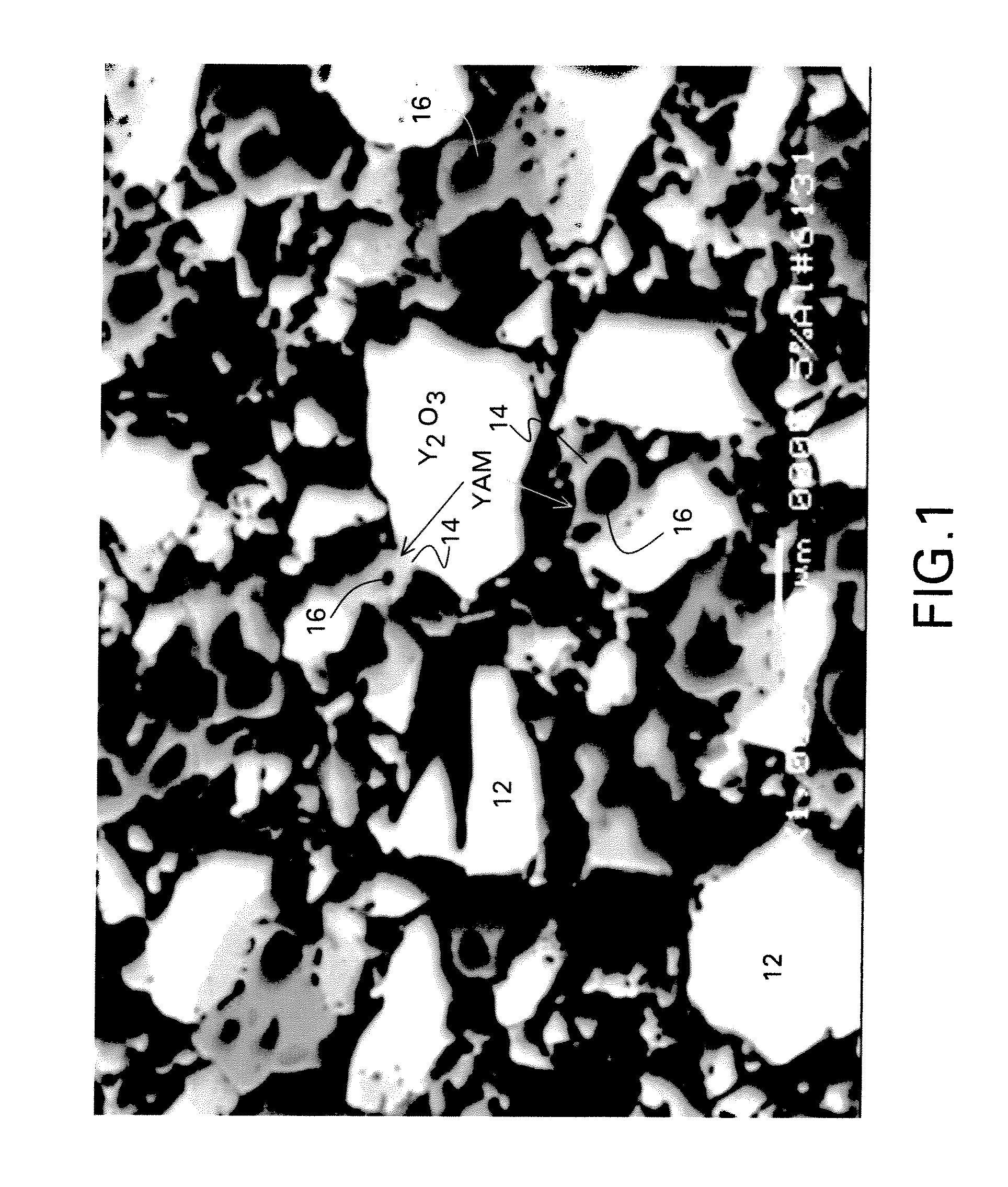Ceramic Cores for Casting Superalloys and Refractory Metal Composites, and Related Processes
- Summary
- Abstract
- Description
- Claims
- Application Information
AI Technical Summary
Benefits of technology
Problems solved by technology
Method used
Image
Examples
example 1
[0069]A core was prepared by dry-mixing a composition based on 5% by weight aluminum metal powder with yttria. A commercial, paraffin-based hydrocarbon wax composition was also incorporated into the mixture by blending at about 90° C., to render the ceramic / binder mixture fluid-like. The composition was then extruded into test bars having dimensions of 50 mm×12.5 mm×4 mm.
[0070]A heat treatment followed, carried out in a conventional oven, with an air atmosphere. The heat treatment schedule involved three major stages: approximately 100° C.-400° C. for wax melting and removal; approximately 650° C.-1100° C. for aluminum oxidation; and then sintering at 1200° C.-1700° C. Multiple hold-times were present at various temperatures within and between the stages. The overall heat treatment time was about 50 hours.
[0071]FIG. 1 is a cross-sectional SEM (scanning electron microscope), at 1000× magnification, of a test bar of the sintered material prepared generally according to the technique s...
example 2
[0073]A core was prepared by dry-mixing a composition based on 5% by weight aluminum metal powder with yttria. The hydrocarbon wax of Example 1 was also incorporated into the mixture, by blending at about 90° C., to render the ceramic / binder mixture fluid-like. The composition was then extruded into test bars having dimensions of 50 mm×12.5 mm×4.0 mm.
[0074]The samples were heated slowly at low temperatures, to completely remove the binder system from the bars. The samples were then heat-treated to a sintering temperature of 1700° C. for about 1 hour. After the final firing step, the average shrinkage of the bars was approximately 2.5% The average strength of the test bars was about 1530 psi.
[0075]One of the samples was then analyzed for the composition of the bulk phase. The sample was crushed and then mixed by hand. Quantitative X-Ray diffraction (XRD) analysis was then performed on the crushed powder, to determine the overall composition of the sample. Table 1 provides a listing o...
example 3
[0076]A core was prepared by dry-mixing a composition based on 5% by weight aluminum metal powder with yttria. As in Example 2, the hydrocarbon wax was incorporated into the mixture by blending at about 90° C., to render the ceramic / binder mixture fluid-like. The composition was then extruded into test bars having dimensions of 50 mm×12.5 mm×4.0 mm.
[0077]The samples were heated slowly at low temperatures to completely remove the binder system from the bars, and then further heat-treated to a sintering temperature of 1600° C.
[0078]One of the bars was then prepared for leaching, by weighing an initial weight of the sintered bar sample. The bar weighed 4.1 g. The sample bar was placed in a Teflon®-sealed container which also contained 69% nitric acid. The Teflon container was then placed in an oil bath of 110° C., for a total time of 4 hours. An attempt was then made to remove the sample from the container. However, only a small amount (less than 0.4 g) of residual powder remained, set...
PUM
| Property | Measurement | Unit |
|---|---|---|
| Percent by mass | aaaaa | aaaaa |
| Percent by mass | aaaaa | aaaaa |
| Percent by mass | aaaaa | aaaaa |
Abstract
Description
Claims
Application Information
 Login to View More
Login to View More - R&D
- Intellectual Property
- Life Sciences
- Materials
- Tech Scout
- Unparalleled Data Quality
- Higher Quality Content
- 60% Fewer Hallucinations
Browse by: Latest US Patents, China's latest patents, Technical Efficacy Thesaurus, Application Domain, Technology Topic, Popular Technical Reports.
© 2025 PatSnap. All rights reserved.Legal|Privacy policy|Modern Slavery Act Transparency Statement|Sitemap|About US| Contact US: help@patsnap.com

